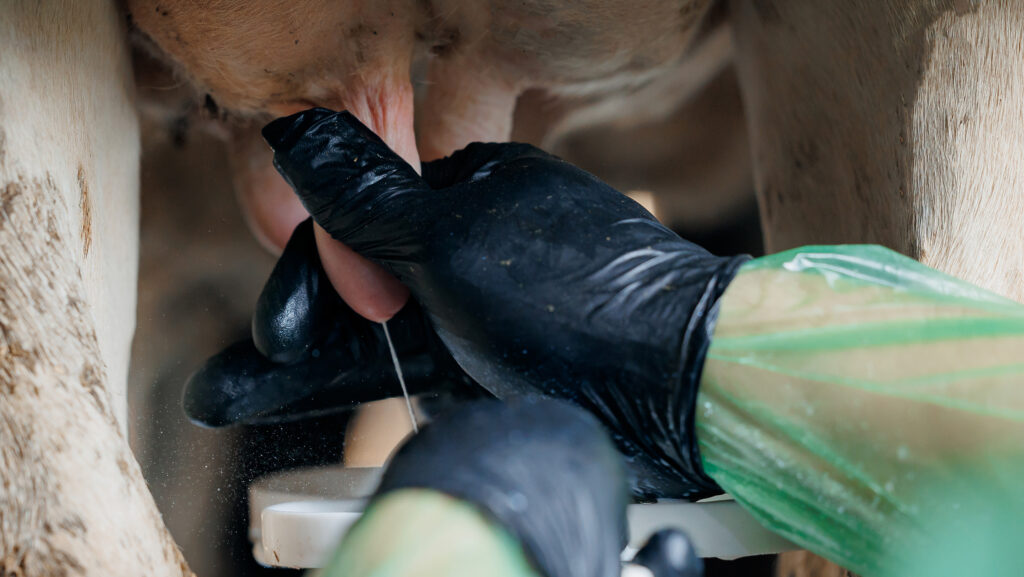How a spring-block herd tackled heifer mastitis
 © Adobe Stock
© Adobe Stock Outwintering heifers to reduce pressure on housing led to a spike in clinical mastitis and herd cell counts peaking near 450,000 cells/ml for a spring block-calving herd in Cumbria.
In the 2019 calving season at Dolphenby Farm, near Penrith, there were 37 cases of mastitis for every 100 cows within the first 30 days of lactation.
Of these, 43% were in freshly calved heifers, said Jonny Slack, who farms in partnership with Robert Craig.
See also: How to reduce mastitis ahead of spring calving
Cell count bonus lost
As a result, the business started to miss out on a 0.5p/litre cell count bonus (for milk below 200,000 cells/ml), amounting to £15,000 over three million litres shipped.
However, working with mastitis control plan deliverer Ian Ohnstad of The Dairy Group, Jonny reported they were able to cut mastitis down to just seven cases in every 100 cows.
“If a case of mastitis costs £250, we saved £37,500 [£250 x 30 x 5]. We are now reducing our use of dry cow therapy and time spent dealing with high cell count animals, so it becomes a sizeable sum of money,” he said.
Alongside savings in time and labour, the additional bonus was the uplift in staff morale, he added.
The herd had grown in size and matured from its start in 2012, and was calving 560 cows by spring 2018. This put buildings under pressure when grazing halted because of “The Beast from the East”, he explained.

Jonny Slack © MAG/Shirley Macmillan
Farm facts: Dolphenby Farm, Penrith, Cumbria
- 283ha farmed in partnership
- 500 crossbred cows
- 250 replacement heifers
- Calving from 10 February
- 6,100 litres a cow
- 400 cubicles, with straw yards for 80
Outwintered heifers
“Data [analysed by Ian] flagged up that heifers in the first 30 days were high cell count and clinical. All our heifers were outwintered – it was wet and messy, even on light land, and we were going over the area two or three times in a winter,” said Jonny.
With no room indoors or options to contract rear off-farm, he realised that outwintering was opening heifers up to an increased risk of infection.
Yet he was sceptical of teat-sealing heifers (despite having worked in New Zealand where it is common policy), but finally agreed to a trial in December 2020. He teat-sealed 74 of the 128 in-calf heifers.
“In February 2021, we calved 62 heifers and 34 cows, and the cell count had risen to 550,000 cells/ml. I CMT’d [California Milk Tested] all of them, and found five heifers with extremely high results – none had had sealant pre-calving,” he explained.
“It gave me confidence to do all heifers that year – 130.”
Heifers were treated initially in a raised foot-trimming crush to make accessing teats easier: “Since then, I have been doing them in the parlour and have been surprised how well they cope. I do it [myself] so if there is an issue, it is my fault.”
Teat warts
Another issue was warts on teats, which affected cleaning, milking and teat condition. As the farm is surrounded by woodland and a river, Jonny said that youngstock grazing was plagued by flies, which helped spread wart virus.
“We were culling two to three heifers each spring because they were unmilkable, so we target youngstock in their first summer with pour-on fly control,” he said.
“This was three to four times a season, and we have stepped it up to every month between May and October. We have also used Stockholm tar every two weeks, with good results. In the last two years, we’ve only culled one heifer with warts.”
Other changes included:
- A third person helping to milk in the 40/80 parlour to avoid overmilking in the absence of cluster removers
- Changing to a better quality teat dip, which gave “a huge improvement in teat condition at little extra cost”
- Moving to monthly milk recording to build up data for future analysis
- CMT-testing every fresh cow and heifer before going into the main herd
- Giving cows with high cell counts anti-inflammatories, Uddermint, and then antibiotics if needed
- Clipping tails four times a year and using an udder-singeing tool.
